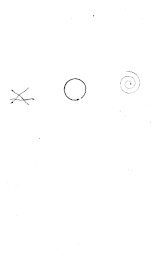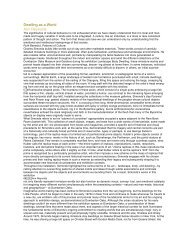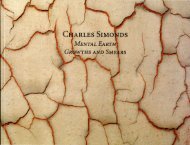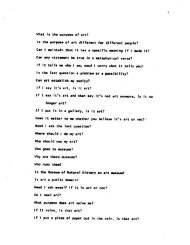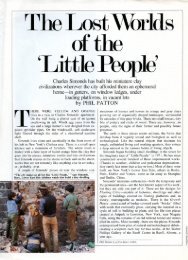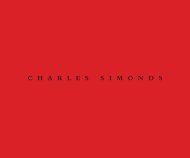Read Catalog - Charles Simonds
Read Catalog - Charles Simonds
Read Catalog - Charles Simonds
Create successful ePaper yourself
Turn your PDF publications into a flip-book with our unique Google optimized e-Paper software.
26<br />
The Tower of Babel is referred to in the Bible (Genesis II :r-9) simply as "a tower with<br />
its top in the heavens." Herodotus refers to a great temple in the center of Babylon<br />
with "a solid central tower, one furlong square, with a second erected on top of it and<br />
then a third, and so on up to eight. All eight towers can be climbed by a spiral way<br />
running around the outside ... " (The Histories, trans. Aubrey de Selincourt, Baltimore:<br />
Penguin Classics, 1961, p. 86). Pieter Bruegel the Elder painted two versions of a Tower<br />
of Babel in 1563, basing his image on the written sources above and his visit to the<br />
remains of the Colosseum in Rome as well as contemporary machines. See H. Arthur<br />
Klein, "Pieter Bruegel the Elder as a Guide to r6th Century Technology," Scientific<br />
American 238, 3 (March 1978), p. 134. In both the "large" and "small" Babels (Vienna<br />
and Rotterdam), Bruegel uses color changes to distinguish newer from older construction.<br />
27<br />
Bib. I 1975, <strong>Simonds</strong> and Abadie, p. 13.<br />
28<br />
" ... I investigate the parallels between the unconscious behavioral patterns (my own,<br />
those of humans and animals) and social and environmental forces, as a means of<br />
provocation and social change. Through new art and architectural possibilities I am<br />
particularly interested in the evolution and psychological implications of sexual interactions<br />
between body and earth, house and body and home, building and growingfrom<br />
the behavior of termites to human social systems ... " (Bib. II 1980, Daval, p. 121).<br />
(See also note 18 above.) " ... and I've learned more from watching the small-brained<br />
genius of the caddis fly larva building its house ... than by studying the work of largebrained<br />
architects" (Bib. II 1980, Foote, p. 29). <strong>Simonds</strong> admires greatly the beauty and<br />
economy of animal structures, from microscopic animals through shells, arthropods,<br />
and the vertebrates. He has a copy of the classic study by Karl von Frisch, Animal<br />
Architecture, trans. Lisbeth Gombrich, New York: Harcourt Brace Jovanovich, 1974.<br />
The first chapter is entitled "The Living Body as Architect-."<br />
29<br />
<strong>Simonds</strong>'s interest in how building reflects living is evident in his work in transitional<br />
neighborhoods and his notes about buildings he sees in his travels. With many artists<br />
he is interested in the "vernacular, anonymous, spontaneous, indigenous, rural"<br />
structures assembled in Bernard Rudofsky's book Architecture Without Architects,<br />
New York: Doubleday, 1964, which accompanied an exhibition of the same title at<br />
the Museum of Modern Art, New York in 1965. See also Rudofsky's The Prodigious<br />
Builders, New York: Harcourt Brace Jovanovich, 1977. An article which expresses an<br />
attitude very similar to <strong>Simonds</strong>'s is Richard Bender's study of mud architecture in<br />
Morocco, "Dust to Dust-The Ultimate System/' Progressive Architecture 54, 12 (December<br />
1973), pp. 64-67.<br />
30<br />
Bib. II 1980, Daval, p. 121.<br />
31<br />
Ibid.<br />
32<br />
See Bib. II 1979, Linker, for an extremely thoughtful and provocative discussion of<br />
<strong>Simonds</strong>'s art, esp. p. 3 7, where she concludes: "Instead of extending art into nonart<br />
contexts, they [his land projects] propose broader, more flexible definitions of art. And<br />
this reorientation of esthetic objectives is perhaps the most important thing that these<br />
objects, like <strong>Simonds</strong>'s Dwellings and models, are about." See also her footnote 17 for<br />
a proposed analogy between the models for Three Peoples and art theories.<br />
24



